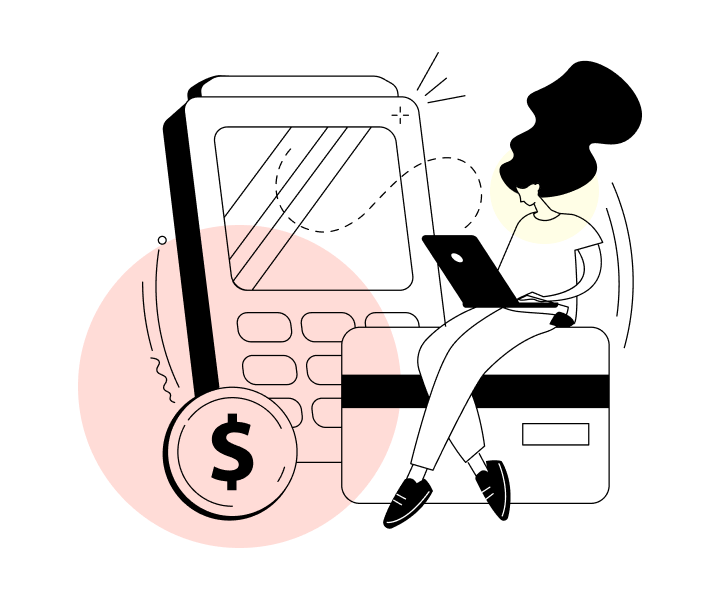How Do I Pay Taxes for My E-commerce Business?
What Every E-commerce Business in Canada Should Know About Paying Taxes
TurboTax Canada
February 13, 2024 | 5 Min Read
Updated for tax year 2025

When you run an online business, your website is your storefront, and the world is your oyster. Whether you’re selling custom prints, vintage clothings, or your own unique art on Etsy, your customers can come from anywhere.
Where there’s income (customers) there are taxes involved.
If you’re ready to wrap your head around the tax implications of starting and/or managing an e-commerce business, this article is for you!
Key Takeaways
- Whether you’re a traditional or web-based business, the same tax laws apply.
- If the revenue from your E-commerce business exceeds $30,000 you’re required to register for a GST/HST number.
- Each province has a different sales tax rate.
Do e-commerce businesses pay taxes in Canada?
Whether you’re a traditional or web-based business, the same tax laws apply. Your tax reporting requirements are driven, not by whether you’re virtual, but by how your business is structured for legal and tax purposes. This is something you decide when registering your business.
Do I need to register my e-commerce business in Canada?
Registering your business is a must, but how you structure it is up to you. An e-commerce business generally falls into one of three categories:
- Sole proprietor: You run your business by yourself and your business is unincorporated.
- Partnership: Your self-employed business is operated by two or more people.
- Incorporation: Your business is run as a separate legal entity (‘the corporation’).
Your business structure determines so many things: how you’re taxed, what your liabilities are, and even the forms you fill out at tax time.
Each set-up has its pros and cons. In case you’re still in the planning stages of your online business venture and unsure about which business structure makes the most sense, TurboTax can guide you.
What if I sell in Canada and also internationally?
The CRA expects you to pay income tax on your online earnings no matter where in the world your customers come from.
From the CRA’s point of view, the only difference between Canadian and international customers is that international customers don’t pay sales tax.
Do I have to charge sales tax?
If your business earns more than $30,000 a year (regardless of whether it’s a profit), you must register for a GST/HST account if you earn $30,000 in a single quarter or the previous 4 or more consecutive quarters. You can also choose to open an account from the start to claim eligible input tax credits. When your business earns more than $30,000, you’ll charge your Canadian customers sales tax as per the rate of the province you are shipping it to (see chart below).
For example: Stephen lives in Ontario and owns an e-commerce store selling art supplies to customers in Canada. Today, he made a sale for $100 to a customer living in Québec. Stephen will need to charge an additional 5% in GST ($5.00) and 9.975% in QST ($9.98) for a total of $114.98 to his Québec customer.
From this transaction he should report $100 in sales, and $14.98 in total sales tax collected on his next sales tax return, based on the 2025 tax rates.
If you’re unsure of whether you’ll clear the $30K mark or want to set up a GST/HST number in advance to get a head start on proper recordkeeping, it’s worth reading up on the ins and outs of registering for, collecting and reporting GST/HST.
Provincial sales tax rates
In name and amount, sales tax varies by province and territory. This handy chart breaks it down (2025 rates):
| Province | Sales Tax Rates |
| Ontario | 13% HST |
| Alberta | 5% GST |
| British Columbia | 5% GST and 7% PST |
| Québec | 5% GST and 9.975% QST |
| Manitoba | 5% GST and 7% Retail Sales Tax |
| New Brunswick | 15% HST |
| Newfoundland & Labrador | 15% HST |
| Northwest Territories | 5% GST |
| Nova Scotia | 15% HST |
| Nunavut | 5% GST |
| Prince Edward Island | 15% HST |
| Saskatchewan | 5% GST and 6% PST |
| Yukon | 5% GST |
How do I report my e-commerce business activities on my tax return?
If your online business is your full-time job, you’ll be taxed on your net income (your total income minus your expenses) just like any self-employed person.
The expectation is to report the percentage of income earned from individual websites, where there is more than one generating sales, relative to gross online sales – not other sources of income such as full-time employment.
TIP: If you’re selling within an external website like Etsy, you should receive an income statement from that online enterprise to use for reporting within your tax return. The gross income reported by you and the external platforms should be the same.
Sales tax might also be collected and remitted on your behalf, as an installment, but you’ll still need to complete and file your sales tax return and pay any remaining balance on time.
It’s worth noting that if your earnings from your online business nudge you into a higher tax bracket, any income in excess of your original tax bracket will be taxed at a higher rate.
What expenses can I claim for my e-commerce business?
Tax deductions are a small business owner’s best friend. As an e-commerce business, you’ll be able to claim many of the same write-offs as a brick-and-mortar store. So try to keep track of every expense, even the small ones. Every receipt adds up and together, they may even knock you into a lower tax bracket.
To ensure you don’t miss a trick, check out our Big List of Small Business Tax Deductions.
How does the Etsy import function work?
- Getting started: Head over to the TurboTax website and choose your preferred product. Click “get started” to begin.
- Login or Create an account: You will get directed to the login page. If you have an account – log in! If you don’t, create a new one.
- Answering Tax Questions: Once logged in, TurboTax will ask you a few tax-related questions in order to understand your unique situation.
- Connecting an Etsy account: After you finish the initial setup, you’ll be asked to connect your Etsy account to TurboTax.
- Granting Access: To link your accounts, enter your Etsy login credentials and input the security code sent to your device for authentication.
- Importing Data: TurboTax will seamlessly link to your Etsy account, securely migrating business information, income and expenses.
- Completing Tax Filing: With all your data pre-filled, you can cruise through the remaining steps of the tax filing process for a seamless experience
See the video below for more information!
Capital Cost Allowance
Unlike typical expenses which you claim in one swoop, the cost of larger business assets, such as office furniture or computer equipment, must be deducted in increments, over time. Office furniture, for example, is deducted at 20% of its value each year, while machinery and equipment is deducted at 30%.
If you’re planning a major purchase or two to support your business, read up on how capital cost allowance works.
Do e-commerce businesses pay taxes in Canada?
Do I need to register my e-commerce business in Canada?
What if I sell in Canada and also internationally?
Do I have to charge sales tax?
How do I report my e-commerce business activities on my tax return?
Related articles

© 1997-2024 Intuit, Inc. All rights reserved. Intuit, QuickBooks, QB, TurboTax, Profile, and Mint are registered trademarks of Intuit Inc. Terms and conditions, features, support, pricing, and service options subject to change without notice.
Copyright © Intuit Canada ULC, 2024. All rights reserved.
The views expressed on this site are intended to provide generalized financial information designed to educate a broad segment of the public; it does not give personalized tax, investment, legal, or other business and professional advice. Before taking any action, you should always seek the assistance of a professional who knows your particular situation for advice on taxes, your investments, the law, or any other business and professional matters that affect you and/or your business.









